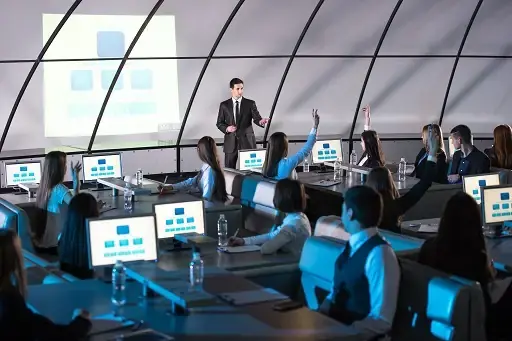How Futuristic Classrooms Revolutionize Education Now
Education has evolved significantly over the years. It moved from traditional classrooms with chalkboards and textbooks. Now, it uses technology and interactive learning methods. As we move forward into the future, the concept of futuristic classrooms is becoming increasingly popular. These classrooms aim to immerse students in learning. They use advanced technologies and innovative teaching methods. This makes the environment engaging.
Futuristic classrooms aim to revolutionize education by providing students with a more interactive and personalized learning experience. These classrooms have advanced gadgets and tools. They improve learning and make it fun for students. The gadgets include interactive whiteboards and virtual reality headsets. These are designed for modern students’ needs.
Key Takeaways
- Interactive learning environments are key to engaging students in the future of education.
- Smart classroom gadgets and tools can enhance learning outcomes and improve student performance.
- Personalized learning with data analytics allows for the power of big data to be harnessed in education.
- Gamification in learning processes can make education fun and increase student motivation.
- Augmenting traditional teaching with AR is the future of education and can improve learning outcomes.
Interactive Learning Environment: The Key to Student Engagement
Futuristic classrooms prioritize interactive learning. They differ from traditional ones, where students just listen to lectures. In these modern setups, students actively participate. This keeps them engaged and interested in the subjects.
Interactive learning environments promote active participation from students. They use various tools and technologies. These tools allow students to interact with content and collaborate with others. For instance, interactive whiteboards let students write, draw, and manipulate digital content live. This approach not only makes learning fun but also boosts critical thinking and problem-solving skills.
Interactive whiteboards are not the only interactive learning tools. There are also virtual reality (VR) headsets. These headsets let students visit various places and eras. This lets students directly explore and experience concepts. Also, gamification platforms make learning fun. They turn learning into a game. This motivates students and makes learning enjoyable.
Smart Classroom Gadgets and Tools: Enhancing Learning Outcomes
Futuristic classrooms have many smart gadgets and tools. These tools use technology to improve learning. They make the learning experience more personal and effective. Adaptive learning platforms use artificial intelligence to review student performance. They give personalized advice and feedback based on this review.
Smart classroom gadgets and tools assist teachers in administrative tasks and enhance learning efficiency. Attendance tracking systems automatically log student attendance. This saves teachers time and effort. Additionally, grading software automates the grading process. This allows teachers to focus more on providing students with feedback and support.
Another smart classroom tool is the digital textbook. These textbooks are full of interactive and multimedia elements. This makes learning more engaging and interactive for students. They offer features for highlighting, taking notes, and searching. These features help students study and understand the content more easily.
Personalized Learning with Data Analytics: The Power of Big Data
One of the most exciting aspects of futuristic classrooms is the ability to personalize learning using data analytics. Data analytics involves collecting and analyzing large amounts of data to gain insights and make informed decisions. In education, data analytics can be used to track students’ progress, identify areas of improvement, and provide personalized recommendations.
For example, learning management systems (LMS) can track students’ performance on assignments and assessments, allowing teachers to identify struggling students and provide targeted interventions. Similarly, adaptive learning platforms use data analytics to analyze students’ learning patterns and adjust the content accordingly. This ensures that each student receives a personalized learning experience that is tailored to their individual needs and abilities.
Big data is also being used in education research to gain insights into how students learn and what factors contribute to their success. Researchers can analyze large datasets to identify trends and patterns that can inform instructional practices and curriculum development. This can lead to more effective teaching methods and improved learning outcomes for students.
Gamification in Learning Processes: Making Education Fun
Gamification is a key feature of future classrooms. It aims to make learning more fun and engaging for students. It uses game design principles and mechanics in non-game areas like education. By incorporating elements such as points, badges, and leaderboards, gamification can motivate students and make learning more fun.
There are many ways in which gamification can be incorporated into the learning process. For example, teachers can create interactive quizzes and challenges that reward students with points or badges for completing them. This not only makes learning more enjoyable but also encourages healthy competition among students.
Gamification can also be used to promote collaboration and teamwork among students. For example, teachers can create group projects or simulations that require students to work together to solve a problem or achieve a goal. By working together in a game-like environment, students can develop important skills such as communication, collaboration, and problem-solving.
Augmenting Traditional Teaching with AR: The Future is Here

Augmented reality (AR) is another technology that is being used in futuristic classrooms to enhance the learning experience. AR involves overlaying digital content onto the real world, creating an immersive and interactive learning environment. By using AR devices such as smartphones or tablets, students can interact with virtual objects and explore concepts in a hands-on way.
AR can be used in various subjects and disciplines to bring abstract concepts to life. For example, in science classes, students can use AR to visualize complex scientific phenomena that are difficult to observe in real life. Similarly, in history classes, students can use AR to explore historical sites and artifacts, making history come alive.
One of the key benefits of using AR in education is its ability to cater to different learning styles and preferences. Some students may learn better through visual or kinesthetic means, while others may prefer auditory or textual information. AR allows students to engage with the content in a way that suits their individual learning style, making it more accessible and effective for all students.
The Benefits of Futuristic Classrooms: Improved Learning Outcomes
Futuristic classrooms offer a wide range of benefits that can lead to improved learning outcomes for students. One of the key benefits is increased student engagement. By creating an interactive and immersive learning environment, students are more likely to be actively involved in the learning process. This can lead to better retention of information and improved understanding of concepts.
Another benefit of futuristic classrooms is personalized learning. By leveraging technologies such as data analytics and adaptive learning platforms, teachers can provide each student with a personalized learning experience that is tailored to their individual needs and abilities. This ensures that students receive the support and resources they need to succeed.
Futuristic classrooms also promote collaboration and teamwork among students. By incorporating tools and technologies that facilitate collaboration, such as interactive whiteboards and gamification platforms, students can work together to solve problems and achieve goals. This not only enhances their social and communication skills but also prepares them for the collaborative nature of the modern workforce.
The Challenges of Adopting Futuristic Classrooms: Overcoming Barriers
While futuristic classrooms offer many benefits, there are also challenges associated with adopting these innovative teaching methods. One of the main challenges is the cost of implementing and maintaining the necessary technologies and tools. Many schools and educational institutions may not have the financial resources to invest in these technologies, making it difficult to create futuristic classrooms.
Another challenge is the lack of training and support for teachers. In order to effectively use the technologies and tools in futuristic classrooms, teachers need to be trained on how to integrate them into their teaching practices. This requires ongoing professional development and support from administrators and educational leaders.
Additionally, there may be resistance to change from both teachers and students. Some teachers may be hesitant to adopt new technologies or teaching methods, fearing that they may be replaced or that their role will be diminished. Similarly, some students may resist the change, preferring traditional methods of learning that they are familiar with.
To overcome these barriers, it is important for schools and educational institutions to provide the necessary resources and support for teachers. This includes providing training and professional development opportunities, as well as ongoing technical support. It is also important to involve teachers in the decision-making process and give them a voice in how the technologies and tools are implemented.
The Role of Teachers in Futuristic Classrooms: Adapting to Change
In futuristic classrooms, the role of teachers is evolving from being the sole source of knowledge to becoming facilitators and guides in the learning process. Teachers are no longer just delivering lectures and providing information, but rather they are creating an environment where students can explore, discover, and construct their own knowledge.
Teachers in futuristic classrooms need to be adaptable and open to change. They need to embrace new technologies and teaching methods, and be willing to experiment and take risks. They also need to be lifelong learners themselves, continuously updating their skills and knowledge to keep up with the rapidly changing educational landscape.
One of the key strategies for teachers to adapt to change is collaboration. By collaborating with other teachers, administrators, and educational leaders, teachers can share ideas, resources, and best practices. This can help them stay informed about the latest trends and developments in education and provide them with a support network.
Teachers also need to be flexible in their teaching approaches. They need to be able to differentiate instruction to meet the diverse needs of their students. This may involve using a combination of traditional teaching methods and innovative technologies, depending on the needs of the students and the subject matter.
Embracing the Future of Education
In conclusion, futuristic classrooms have the potential to revolutionize education by creating immersive and engaging learning environments for students. These classrooms utilize advanced technologies and innovative teaching methods to enhance learning outcomes and make education more enjoyable for students.
By creating interactive learning environments, utilizing smart gadgets and tools, personalizing learning with data analytics, incorporating gamification, and leveraging augmented reality, futuristic classrooms offer a wide range of benefits that can lead to improved learning outcomes for students.
However, there are challenges associated with adopting futuristic classrooms, such as the cost of implementing and maintaining the necessary technologies, the lack of training and support for teachers, and resistance to change. To overcome these barriers, it is important for schools and educational institutions to provide the necessary resources and support for teachers and involve them in the decision-making process.
Ultimately, embracing the future of education requires a shift in mindset and a willingness to adapt to change. By embracing new technologies and teaching methods, teachers can create a more engaging and effective learning experience for their students. It is important for educators to recognize the importance of embracing change in education and to take action to create a brighter future for our students.
If you’re interested in exploring more about the role of AI and ML education in K-12 learning, you should definitely check out this insightful article titled “Commentary: Nurturing Tomorrow’s Leaders – The Crucial Role of AI and ML Education in K-12 Learning.” It delves into how these technologies are reshaping the educational landscape and preparing students for the future. To read the full article, click here.
FAQs
What are futuristic classrooms?
Futuristic classrooms are learning spaces that incorporate advanced technology and innovative teaching methods to enhance the learning experience of students.
What are the benefits of futuristic classrooms?
Futuristic classrooms offer a range of benefits, including improved student engagement, personalized learning experiences, increased collaboration, and enhanced teacher effectiveness.
What technologies are used in futuristic classrooms?
Futuristic classrooms use a range of technologies, including interactive whiteboards, virtual and augmented reality tools, 3D printing, and artificial intelligence.
How do futuristic classrooms enhance student engagement?
Futuristic classrooms enhance student engagement by providing interactive and immersive learning experiences that are tailored to individual student needs and interests.
How do futuristic classrooms promote collaboration?
Futuristic classrooms promote collaboration by providing students with opportunities to work together on projects and assignments using digital tools and platforms.
How do futuristic classrooms benefit teachers?
Futuristic classrooms benefit teachers by providing them with tools and resources that help them to deliver more effective and engaging lessons, and by enabling them to better track student progress and provide personalized feedback.
What are the challenges of implementing futuristic classrooms?
The challenges of implementing futuristic classrooms include the cost of technology, the need for teacher training and support, and the potential for technology to distract from traditional teaching methods.






